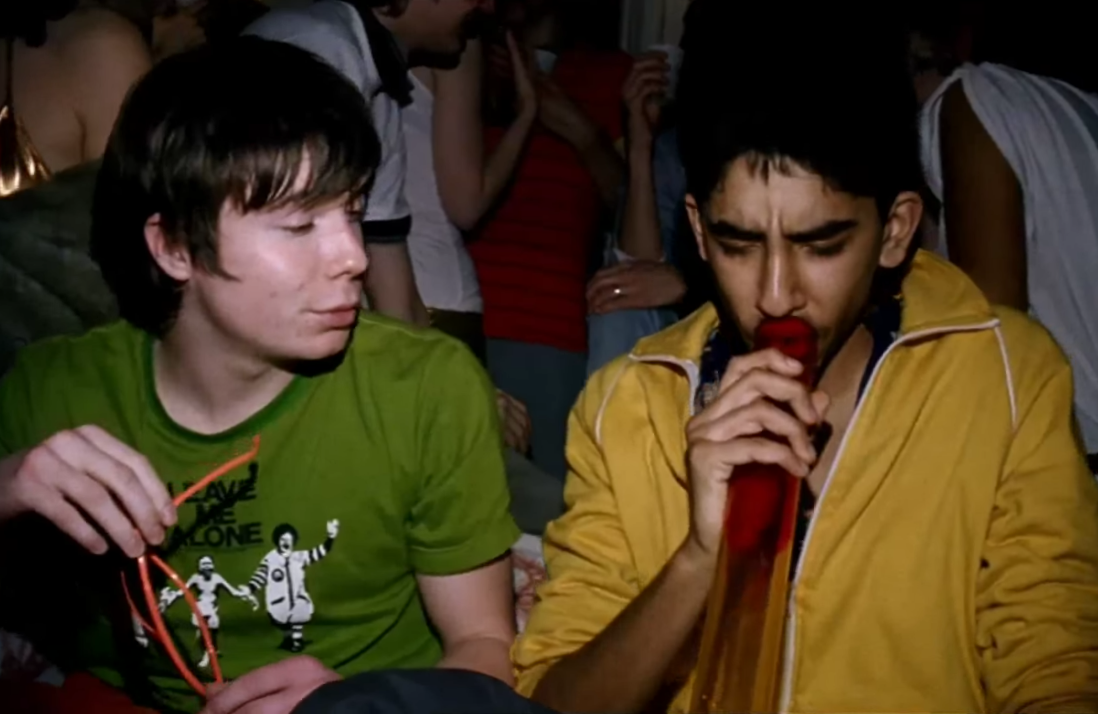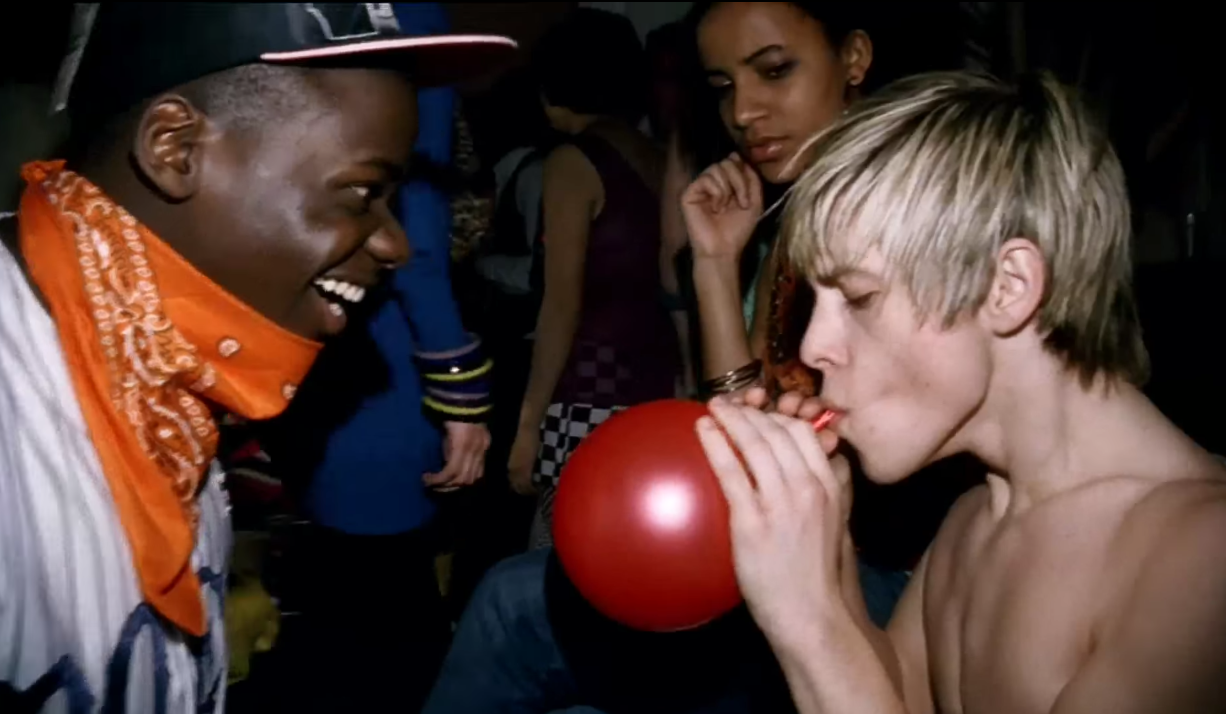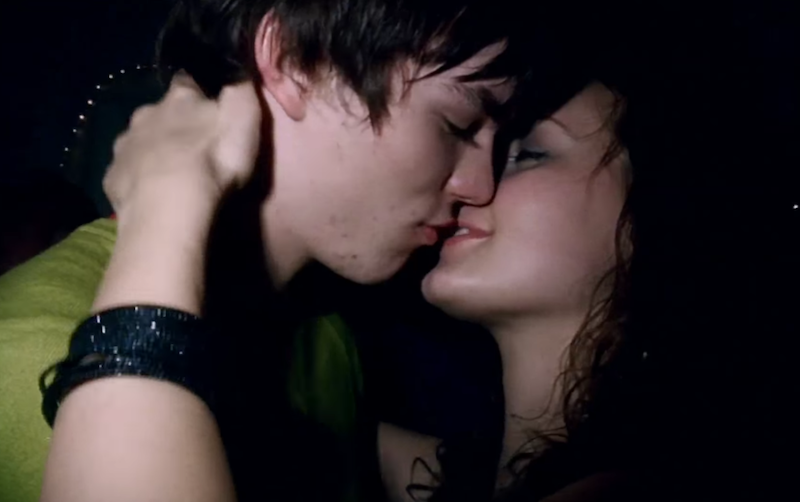(All images: screen shots via E4 Skins season one advert)
Maybe it was because I’d just hit 15, or perhaps it was a direct result of the show, but when Skins came out in 2007 the house parties I’d been going to changed. Where they had previously involved drinking a bottle of Jacob’s Creek stolen from your mum and hopefully getting fingered behind a sofa, they suddenly escalated to the point where people were doing coke and having actual full sex, very badly, surrounded by K-holing kids from schools other than my own.
Videos by VICE
We might not have been as hot as Tony Stonem or Cassie Ainsworth, and rural England wasn’t as cool as Bristol – where, according to Skins, 17-year-olds can tick three ounces of “spliff” off legitimate drug traffickers – but everyone there was cut from the same cloth, or at least aspiring to be.
The E4 show, which premiered a decade ago today, made Britain’s teenage parties look sexy, sweaty and confident in a way TV had never really attempted before, let alone succeeded in doing. And radically, while asterisking the potential dangers and after-effects of drugs, the show made using substances look like a lot of fun. While it wasn’t without its cringy moments, it also wasn’t Hollyoaks, where characters got “addicted” to weed and smashed up gravestones; it was as close as any show had come to representing how teenagers really use drugs.
Naturally, out of that first season came the phenomenon of “Skins parties” – house parties that aspired to be every bit as nasty as those on the show and in its ads: an American Apparel look-book made flesh, with just as much nudity, lots more vodka and a fist-full of pills.

For some, the term “Skins party” was pure irony; a knowing nod to the fact you’d bought some MDMA for a house party and that there would probably be some dickhead there waving glow sticks about. But for many, it became part of the common lexicon. The infamous party thrown at Rachael Bell’s house, in which 200 people turned up and caused £25,000 of damage, was advertised online as having a Skins theme. So of course the tabloids picked up on this and jumped on the idea of cause-and-effect: that British teenagers had suddenly ramped up their partying because they’d been directly inspired by the casual sex and drug use they saw on Skins.
Of course, this is slightly ridiculous: teenagers have been having sex and doing drugs for decades. But you could argue that the show exposed a generation of underage small-towners to the kind of party culture they might not have encountered until university. Either way, the term is now immortalised on Urban Dictionary as “a huge party in someone’s house where nearly everything is broke, lots of people are having sex and almost everyone is either drunk or drugged up”, and that “self consciously aspires to be infamous, preferably on the evening news”.
This was the era in which social media was really starting to come into its own, and it was via Myspace that all those kids heard about Rachel Bell’s party, flocking to her home in a town near Sunderland from as far afield as London and Liverpool. Seven police vehicles, including a dog van, turned up to find “yobs” having sex in every room and curtains ripped down from windows. As Bell’s mother Elaine put it dramatically to the Daily Mail: “The house has been raped. Every carpet’s burned where they’ve stomped out cigarettes. They’ve urinated in wardrobes, pulled my clothes out and stubbed cigarettes on them. The beds have burns, food has been smeared everywhere and messages scrawled all over the walls.”
After being arrested and released on police bail while a criminal damage inquiry was underway, Bell’s defence was that her Myspace account had been hacked and that someone else had posted the open invitation.

Another infamous “Skins party” started out as a quiet “get-together” advertised by four female students from Bournemouth, and ended up being attended by over 300 guests, who vandalised the house and took part in “alfresco urination”, according to the Telegraph. The party got so out-of-hand that one quick-thinking entrepreneur set up a stall selling alcohol in the middle of the road. It was broken up by 20 police officers and an air-support helicopter. Which is nothing, really, compared to the “Roman-style orgy” at a house in Sussex the week before, which ended with teens drugging the family dog.
It wasn’t long before the trend made it overseas. By 2009, French students were going to “Skins parties” described as “the craziest thing in French nightlife, where girls are loose and drugs roam free”. Except, by this point, they had become more legitimate club nights than parties that destroyed people’s homes – a phrase promoters tacked onto posters and Facebook event pages to imply their parties would be decent. A “Dance Until You Drop” for the Myspace generation.
They were rowdy versions of new rave fancy dress nights in Oceana or Coalition, full of European frat boys and girls wearing neon glasses and hot pants. “Authorities are keeping tabs on them, sponsors are showing up, top DJs are part of the line-up and there is tighter security,” one 19-year-old French student told a publication at the time. “I’d say there was too much security; at the last one I went to they were kicking out people who rolled joints.”
Crucially, though, minors weren’t allowed into these nights, defeating the beauty of what happened on TV, in a show that explored what teens too young to go to clubs or bars do to escape.

Looking back at Skins on the tenth anniversary of its first episode, it’s hard to say what long-term effects it had on partying. Since 2007, going out has become both more expensive and just more difficult to do, thanks to the closure of half the country’s nightclubs, so young people are undoubtedly staying in and more and more, and bringing the party to them. That said, to me, it’s not since the mephedrone craze of 2009 and 2010 that UK house parties really felt like the debauched nights in that Skins featured in its season one ads.
What’s certain, though, is that there’s been no British teen drama that’s caught the attention of the average suburban 15-year-old in the same way since. It wasn’t the best written show, and it wasn’t, by many people’s standards, an exceptionally brilliant programme altogether, but the only thing that’s come close to achieving what it did in the past decade is The Inbetweeners and its bumbling troupe of middle class virgins. Four guys who represented a very different type of teenage experience.
Skins, on the other hand, taught a very specific type of Bombay Bicycle Club-loving, NME reading British teenager how to party, and for that I doubt it will be forgotten any time soon.
More on British TV:
I’d Never Been On ‘Pointless’, Went On It and Won
More
From VICE
-

AEW -

Photo by FG Trade -

Pick up our top water flosser pick, this water flosser from Waterpik. Yeah, say that three times fast, you coward. -

Screenshots: Techland, Sega, Eidos Interactive
